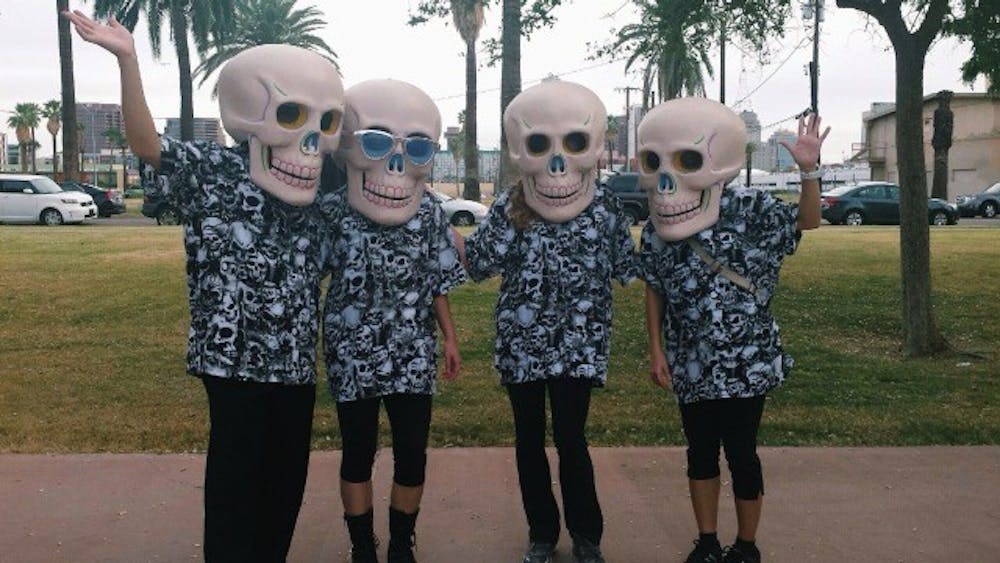 A group of dancers pose for photos before performing with Mariachi Real de Jalisco on Sunday, Oct. 26 at Margaret T. Hance Park. (Photo by Celina Jimenez)
A group of dancers pose for photos before performing with Mariachi Real de Jalisco on Sunday, Oct. 26 at Margaret T. Hance Park. (Photo by Celina Jimenez)It may translate to "Day of the Dead," but Día de los Muertos is nothing short of lively.
Celebrated primarily in Mexico, Día de los Muertos is a bank holiday during which families honor and remember deceased loved ones through traditional festivals and rituals. Today, many Phoenix residents gathered at Margaret T. Hance Park to take part in this tradition.
Guests of the event were able to witness traditions such as the Aztec Blessing and hear classic cultural music from many diverse groups, including a mariachi band. People of all ages were entertained by the nonstop activity at the park, and the festival appealed to guests of all ages and diverse cultural backgrounds.
 Guests of the Día de los Muertos festival brought mementos and photos of deceased loved ones to display in the Community Altar on Sunday, Oct. 26 at Margaret T. Hance Park. (Photo by Celina Jimenez)
Guests of the Día de los Muertos festival brought mementos and photos of deceased loved ones to display in the Community Altar on Sunday, Oct. 26 at Margaret T. Hance Park. (Photo by Celina Jimenez)The festival also featured a Community Altar where guests could place mementos and photos of their loved ones in order to honor them alongside the rest of the community.
Sisters of ASU's Kappa Delta Chi sorority were also present. Nursing Erolinda Becerra and industrial engineering Adriana Urias, both 22, said they were helping out with the various children's activities and handing out surveys.
For Mars Dueñas and Karlyn Busche, the festival was a fun way to unwind after the work week.
Dueñas said that her favorite parts of the festival were "the music, the costumes and the culture."
All three of these things comprised the majority of the festivities. Other activities included art and jewelry booths, face painting and craft centers for kids. Guests also enjoyed taking photos with costumed entertainers and eating diverse food from various vendors.
 Members of Quetzalli Ballet Folklórico pose for photos before performing their "Las Coronas" routine on Sunday, Oct. 26 at Margaret T. Hance Park. (Photo by Celina Jimenez)
Members of Quetzalli Ballet Folklórico pose for photos before performing their "Las Coronas" routine on Sunday, Oct. 26 at Margaret T. Hance Park. (Photo by Celina Jimenez)Amongst the entertainment at the festival was a group of Phoenix dancers known as Quetzalli Ballet Folklórico. Ballet folklórico is a style of dance that embraces and expresses traditional Mexican heritage and culture. Clad in traditional dresses and painted masks to commemorate the holiday, dancers Samantha Navarette and Andrea Lee-Cruz explained the style of dance and their involvement in the group.
"I started when I was about five," explained Lee-Cruz, who is now 11 years old. Navarette has also been involved in the group for several years.
The girls' devotion is a powerful example of how committed the Mexican culture is to honoring deceased loved ones and keeping memories alive. The night ended with a candlelight procession, which honors the tradition of collectively proceeding to various burial sites in order to honor the dead.
Regardless of ethnic background, nationality or beliefs, Día de los Muertos is a rich and beautiful expression of love and honor for beloved ancestors. This festival was a shining example of the way a mutual desire for respect and togetherness can connect a community.
Reach the reporter at celina.jimenez@asu.edu or follow on Twitter @lina_lauren
Like The State Press on Facebook and follow @statepress on Twitter.




